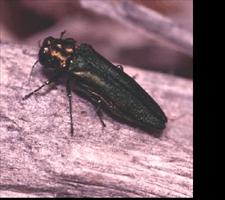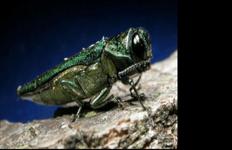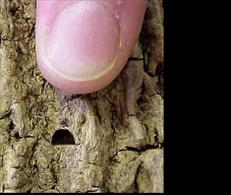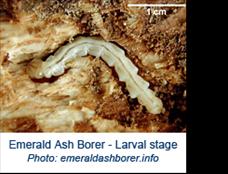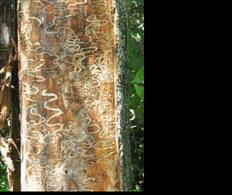Emerald Ash Borer
Yes, the Emerald Ash Borer (EAB) has been found in Wisconsin. EAB was first discovered in southeast Michigan in 2002 and has since been found in eight other states, including Wisconsin. On August 1, of 2008, emerald ash borer was discovered near and in the village of Newburg in Ozaukee & Washington Counties. The size of the infestation is currently unknown and surveys to determine the extent and age of the infestation are ongoing. Large purple, kit like, sticky traps are being placed throughout the state to help determine if adult insects are present and girdled detection trees are also being peeled and examined in an effort to determine if EAB larvae are present.
The Wisconsin Department of Agriculture, Trade and Consumer Protection (DATCP) declared a quarantine for all of Ozaukee, Washington, Fond du Lac and Sheboygan Counties. The quarantine restricts the movement of hardwood firewood, ash nursery stock
ash logs and any other ash products that could transport EAB.
What does this mean for the City of Watertown and the surrounding area? It appears that it is just a matter of time before we will be dealing with this deadly pest. Watertown, like most communities, has a significant number of ash trees. The control EAB, removal and disposal of the dead trees will be very expensive. The devastation very well could become comparable to that of the Dutch Elm Disease, which devastated the American Elm tree population in the 1960's and 1970's. EAB does not distinguish between ash species. It will attack all ash species, including green, white, blue and black Ash. Mountain Ash, which is not a true ash, is not affected by the borer.
It is estimated that the City of Watertown has approximately 2,500 ash trees growing on city street terraces. It is estimated that the ash population on private property is approximately ten times that of the street terrace numbers. One can easily see that the EAB posses a very serious and potentially expensive threat to the city and the surrounding area. The removal and disposal of 27,000 to 28,000 city ash trees would be a very daunting task. EAB kills large areas of ash trees very quickly and its arrival will present enormous budget and workload challenges. If trees are not removed while they are still green, they become very brittle and much more dangerous and expensive to remove.
Watertown Forestry Department officials are continuing to monitor the situation and have taken a more aggressive approach to removing declining ash trees. The planting of ash trees on street terrace right-of-way is no longer permitted. The department is also in the process of developing an EAB Readiness Plan. To help prevent the spread of EAB, citizens are reminded that firewood should not be transported out of the area in which it has been cut. Citizens are encouraged to inspect their ash trees and look for symptoms of the emerald ash borer and report concerns to the department at 262-4080.
Symptoms of an EAB infected ash include:
Dying trees with sprouts on the trunk or at the base of the tree.
D-shaped exit holes in the bark.
S-shaped tunnels underneath the bark.
Bullet-shaped, ½ inch long, iridescent green beetles from June to August.
